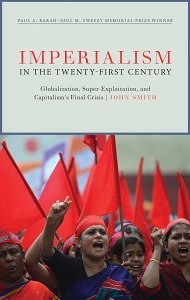Imperialism in the Twenty-First Century: Globalization, Super-Exploitation, and Capitalism’s Final Crisis
384 pp, $28 pbk, ISBN 9781583675779
By John Smith
Reviewed by J. Z. Garrod in Science and Society, pp 148-51, vol. 82, no. 1, January 2018
It takes John Smith all the way until page 95 to tell the reader that “a new version of dependency theory is precisely what [this book] is seeking to develop.” Smith can be forgiven (slightly) for taking so long to inform the reader of his purpose because, to get there, he must necessarily take a somewhat roundabout route through the various forms of “super-exploitation” that characterize our contemporary period, “the latest stage of capitalism’s imperialist evolution” (34).
The book forgoes a standard introduction and instead starts with an illuminating analysis of a few “global” commodities: the t-shirt, the iPhone, and a cup of coffee. The first chapter (“The Global Commodity”) masterfully demonstrates the reality of what Marx termed “commodity fetishism,” that is, the multitude of social relationships that are embodied in each and every commodity. In all three of these examples, there are significant transfers of wealth from the Global South to the Global North: “Gross profits, that is, the difference between their cost of production and their retail price, are far in excess of 50 percent, flattering not only Northern firms’ profits but also their nations’ GDP” (34).
This analysis sets up the two chapters that follow on outsourcing, or, as Smith puts it more accurately, “the globalization of production” (39). In his view, this latest stage of capitalism is simply the “continuation, on a vastly expanded scale, of capital’s eternal quest for new sources of cheap, readily exploitable labor-power” (39–40). The second chapter provides a good overview of the literature on outsourcing and export-oriented industrialization, and argues against claims that the Global South remains mired in poverty because of its failure to “integrate” itself into the global economy. In actual fact, “those poor nations that have found success in reconfiguring their economies in line with neoliberal prescriptions have succeeded only in joining a race to the bottom” (67). This point is further extrapolated in the third chapter, where Smith looks at the two forms of the outsourcing relationship: foreign direct investment (FDI), and arm’s-length. Using a wealth of empirical evidence, Smith finds that there is very little competition between Northern and Southern firms; that what exists instead is a system of world trade in which Northern firms compete primarily against each other.
Chapters four through six continue this general theme. The fourth chapter (“Southern Labor, Peripheral No Longer”) focuses on the global working class, in particular disproving the thesis that lower Southern wages are the result of lower productivity. The fifth chapter explores some of the problems associated with calculating global wage trends, such as the role of floating national currencies in distorting the data. This distortion hides the fact that the North–South divide is growing larger, not smaller. Chapter six (“The Purchasing Power Anomaly and the Productivity Paradox”) continues this analysis by critiquing mainstream explanations that rely on a nebulous understanding of productivity to describe the divergence in purchasing power between the North and the South.
Chapters seven through nine shift focus away from the mainstream approaches and toward a critique of contemporary theories of imperialism. The seventh chapter focuses on global labor arbitrage (i.e., when firms utilize countries with cheaper labor) and why orthodox Marxist critics in Europe and North America are wrong to critique dependency theory for shifting the discussion back to the core and away from the globalization of production and its implication for profits, wages, and so on. Chapter eight continues this theme, and is essentially where Smith provides the theoretical basis for his own theory of dependency. The reader is taken through some classical theories of imperialism, toward the Monopoly Capital school, and then back again toward Marx — in particular, the concept of super-exploitation, when “the wage of the worker is pushed down below the value of his labor-power” (237). The main impetus of the chapter is to make clear that super-exploitation is the third form of surplus-value increase and “the increasingly predominant form of the capital–labor relation” (250) today. The ninth chapter (“The GDP Illusion”) returns the reader to chapters four through six, exploring how GDP hides the vast flows of value from the South to the North, as well as the super-exploitation inherent in those activities. Chapter ten (“All Roads Lead Into the Crisis”) concludes by claiming that the entire capitalist system is moving headlong into its final crisis; that the 2008 financial crisis was not “just another crisis of capitalism,” but rather, a “crisis of imperialism” (314). On the final pages, Smith notes that capitalism’s tendency to exhaust labor and nature means “that this is not just capitalism’s greatest-ever crisis, it is capitalism’s final crisis, an existential crisis for humanity” (315). The book finishes with a poignant quote from Cuban revolutionary leader Raúl Valdés Vivó, who said that our choice is no longer “‘socialism or barbarism,’ as Rosa Luxemburg said in 1918, but socialism or nothing” (315).
It is not surprising that Imperialism in the Twenty-First Century won the Paul A. Baran–Paul M. Sweezy Memorial Prize, awarded by Monthly Review to work on the political economy of imperialism. The book is an empirical tour de force. Smith weaves masterfully between the various categories of mainstream economic thought, demonstrating not only how misleading they are, but how consistently they cover up the transfer of wealth from the Global South to the Global North. There are also extremely valuable insights into the changing form of the global capital–labor relation — in particular, the various forms of outsourcing — and how the entire edifice is crafted on two different layers of capitalist competition in which firms from the Global North compete with each other, firms from the Global South compete with each other, but neither crosses the divide.
All that said, I do have some reservations. First, this is not a text for the average reader; it presumes familiarity with the work of Marx and, in particular, the labor theory of value, on which the book relies heavily. Second, despite the use of the term “imperialism” in the book’s title, and indeed throughout the text, the term itself is never really unpacked. There are small reviews of various theories of imperialism and dependency in the seventh and eighth chapters, but that hardly constitutes a thorough definition of the term itself. This lack is significant, given the many critiques of the idea that globalization is a form of imperialism, as for example in the work of William Robinson, Saskia Sassen, and Hardt and Negri, to name but a few.
In any case, and despite questions about seeing globalization as a form of imperialism, Smith’s Imperialism in the Twenty-First Century is now my go-to book with regard to outsourcing and to the economic categories used to measure the global economy. From now on, when someone asks me, “Do you know anything about outsourcing?” I can happily respond: “Have you read Imperialism in the Twenty-First Century?”
J. Z. Garrod
Department of Sociology and Anthropology
Careton University
Ottawa, Canada


Comments are closed.